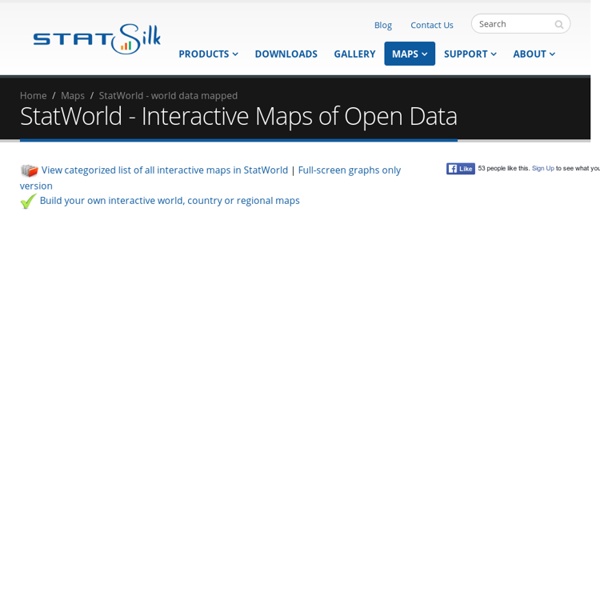



http://www.statsilk.com/maps/world-stats-open-data
Related: Webmapping - Datavisualisations - Open dataCartography of the Anthropocene - Globaïa The Anthropocene: A primer. The Anthropocene. We’re already there. This is our time, our creation, our challenge. Officially, this epoch does not exist. StatPlanet World Bank - Open Data Explore World Bank Data StatPlanet World Bank enables you to explore, analyze and filter any of the 8000+ indicators in the form of interactive maps and graphs, through the intuitive StatPlanet interface. The data is retrieved live from the World Bank database, so is always up to date. The data is made available through the World Bank's Open Data initiative, and includes data on a wide range of topics from Agriculture to Science & Technology. 13 Great Tools for Creating Your Own Maps to Use in Class February 11, 2016 Today we have spent sometime going through our Map Tools archive and curated for you the collection below. These are some of the best tools out there that you can use with you students in class to create, annotate and share maps. We invite you to check them out and share with your colleagues. 1- Google My Maps My Maps offers a high level of detail and customization.
The Geotagger's World Atlas Every city has something unique about it, whether it’s a memorial statue, a cool coffee shop, a world-renowned museum or a local pizza parlor. These places are visited by hundreds or maybe even thousands of people a year, which translates to dozens of photos, many of which are geotagged to show the location of these popular and special places. So, what would happen if you took all of those photos and created a map, linking the photos to show individual journeys and locations? Well, you would end up a neat sketch-like image of the location, filled with individual travels and popular locations.
Acerca de Nosotros The Sunlight Foundation is a national, nonpartisan, nonprofit organization that uses the tools of civic tech, open data, policy analysis and journalism to make our government and politics more accountable and transparent to all. Our vision is to use technology to enable more complete, equitable and effective democratic participation. Our overarching goal is to achieve changes in the law to require real-time, online transparency for all government information, with a special focus on the political money flow and who tries to influence government and how government responds. And, while our work began in 2006 with only a focus on the U.S. Congress, our open government work now takes place at the local, state, federal and international levels. We believe that information is power, or, to put it more finely, disproportionate access to information is power.
AfricaMap Powered by WorldMap AfricaMap Sign in | Create Map | View Map | Help Mapline Blog How to Make an Awesome Data Visualization with Pin Map What is a Pin Map? 1 location = 1 pin Got the idea? Acerca de «Net-Map Toolbox Watch Net-Map introduction video: evaschiffer_netmaps_ifpri <p>JavaScript required to play <a hreflang="en" type="video/mp4" href=" Listen to podcast (0 min 22 sec – click player below) Net-Map is an interview-based mapping tool that helps people understand, visualize, discuss, and improve situations in which many different actors influence outcomes (Net-Map Brochure: 679 KB). By creating Influence Network Maps, individuals and groups can clarify their own view of a situation, foster discussion, and develop a strategic approach to their networking activities.
GIS Data Use GIS Data Use in Bangladesh MEASURE Evaluation collaborated with the Centre for Urban Studies to map the slums surrounding the six largest cities in Bangladesh in 2005. Researchers identified and collected data from more than 9,000 slums, and then used GIS to produce detailed maps that mark each slum’s geographic boundaries, population size and distribution, water sources, legal status, and other information. These comprehensive maps have enabled policymakers to target slum populations with far more efficiency and precision than in the past. Case Study: Using GIS Information to Target Health Services in Slum Areas in Bangladesh Improving HIV Programs in Tanzania with Mapping I-Map: Common Outputs Interactive Map of Irregular and Mixed Migration Routes in the Budapest Process, Mediterranean Transit Migration Dialogue and Prague Process Regions This interactive map is a common output of the BP, MTM and PP. It was elaborated on the basis of the 2012 MTM Map on Irregular and Mixed Migration Routes, the 2010 Prague Process "Building Migration Partnerships" Map on Illegal Migration Routes and the 2013 Mapping of Migration Routes in the Silk Route Region. Please note that data collection methods vary from one project to the other. This map only provides an overview of irregular and mixed migration routes in the above mentioned regions.